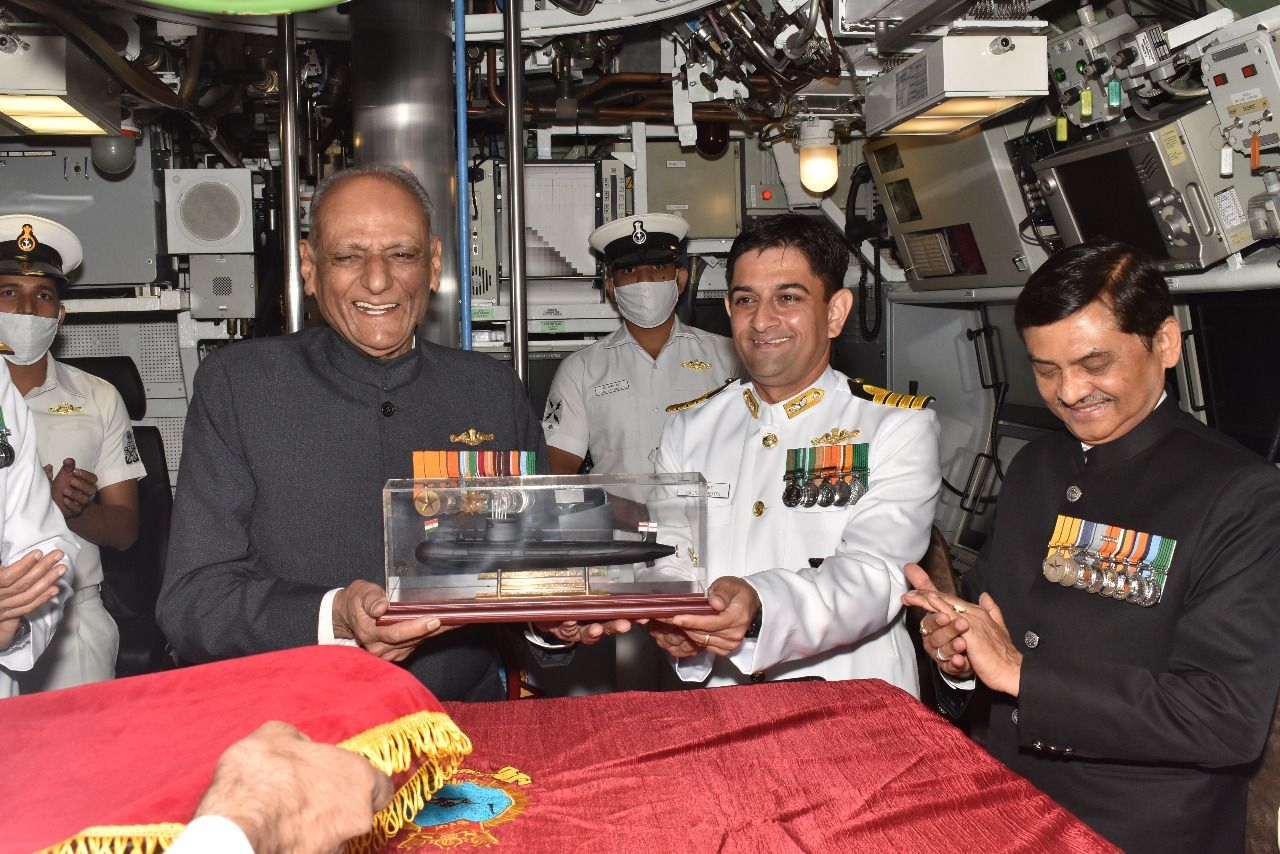‘INS Karanj is the Best Submarine & Crew in the World’
By
Priyanka Chandani

As India celebrates 50 years of the 1971 India-Pakistan war over the liberation of East-Pakistan that resulted in the formation of Bangladesh, the Indian Navy which played a crucial role in winning the war, recently inducted the third Scorpene class Submarine INS Karanj. The name embodies the spirit of the erstwhile INS Karanj (S21), a Foxtrot Class Submarine which was first commissioned in 1969 in the Indian Navy under Project 641.
The erstwhile INS Karanj was procured from the former Soviet Union, and served the Indian Navy until 2003, playing a pivotal role in 1971 war. In order to boost the Indian Navy’s capabilities to deter misadventure by the enemy, conduct ISR missions and to undertake sea denial missions in times of crisis, the new INS Karanj under the Project-75 was commissioned into the Indian Navy on 10 March 2021 at Mumbai.
The Scorpene class diesel-electric attack submarine was jointly developed by French and Spanish maritime companies. INS Karanj is the third submarine under Project-75 and significantly, the first to be completely built in India at Mazagon Dock Shipbuilders Limited (MDL) Mumbai. It is said to be one of the most advanced conventional submarines in the world. With advanced technologies and equipped with potent weapons and sensors, making it the stealthier and deadlier submarine.
The submarine is built under the vision of India’s Atmanirbhar Bharat Abhiyan (Self-reliant India campaign). The Commanding Officer (CO) of INS Karanj Captain Gaurav Mehta sheds light on its construction, the crew, and the life of a submariner in detail.
Captain Gaurav Mehta was commissioned into the Indian Navy on 1 July 2001. He is an alumnus of the 60th Naval Academy course, from where he passed out with the Chief of Naval Staff Bronze medal and commissioned into the Submarine Arm. He stood first in the Basic Submarine Course and has aced several professional courses like the Shishumar Class Conversion Course, Long ASW and Principal Control Officers Qualifying Course.
Prior to his appointment as commissioning EXO, INS Kalvari, he served on Sindhughosh Class and Shishumar Class submarines and has experience in several forward deployments, weapons firing and tactical exercises. His previous command tenures include command of INS Kalvari. He was appointed CO (Desig) of Karanj on the country’s 74th Independence Day.
Excerpts from the interview…
Q. Please tell us about the indigenous factor of INS Karanj?
Ans: INS Karanj is the third boat in the series of six Scorpene boats which is truly indigenous. The first two boats were built under the supervision of the French overseeing team. The P-75 contract said the technology needs to be transferred from France to India in such a manner that we can make these boats on our own.
So, the first two boats, Kalvari and Khanderi were the process of this Transfer of Technology (TOT). The Indian yard learnt this process from the French team and Karanj is the first submarine built without any French overseeing team, thus making this boat truly built in India by MDL and by our designing team.
The process of technology transfer has been completed with this boat. In addition, the training too was done by Indian Navy’s submarine training team and the crew dived the boat successfully. We can say that we have achieved the transfer of technology not just in the construction part but by imparting training as well and we have come out better than before.
Q. How does INS Karanj stand out among Kalvari and Khanderi?
Ans: The submarine construction is extremely complicated even when you have done the building part there are challenges one has to deal with. The first boat is always, even if it is built with the proven designs, an experiment. There are many lessons we have learnt from the first boat and applied them on the second boat. In this regard INS Karanj has come out extraordinarily strong as we had two boats in the past to learn our lessons from and make this one the best so far.
Also, when a boat is taken over by the Navy, the yard still has some liabilities but in case of Karanj the liabilities are very less. Moreover, India has been operating submarines since 1967 and it’s been over 50 years for us operating submarines of different classes and from different countries. Our first pioneers got trained in the UK, and then we got Russian submarines, then German and finally the French.
There is a process of how other countries look at submarines and we have considered all their viewpoints such as standard operating procedures, ergonomics, habitability, safety and incorporated the best of everything in Karanj. We can safely say that this is one of the best boats and crew in the world.
Q. What will be the role of INS Karanj?
Ans: A submarine can be best used in sea denial role, which means when we deploy a submarine in a certain area then the enemy will not be able to use that space effectively and if it does then it has to bear the consequences. Other roles are intelligence gathering in enemy area, laying mines or clandestinely launching marine commandos (MARCOS) close to the enemy coast.
We can also deploy the submarine close to our own coast in a defensive role. Whenever a situation arises, the submarines are given suitable roles and all of them are capable of doing any role.
Q. How do you prepare your team and yourself mentally and physically to stay in arduous environments?
Ans: Submariners are an incredibly special breed of human beings and I say this with full conviction. On board these vessels everything is a challenge. While dived there is a restriction on almost everything – air, water, light everything is rationed.
We may get to take a bath in 4-5 days, there is no sense of time of the day as there is no sunlight and whatever we do is a challenge in normal circumstances. When a submariner goes through this process in training and actual deployment, he comes out as a resilient individual mentally and physically prepared for any challenge.
Q. How do you keep your team motivated?
Ans: My task becomes quite easy because the entire crew are volunteers. They join Indian Navy, serve on surface vessels and some seek brave new challenges by doing something more adventurous and thus volunteer to join the submarine arm. The life of a submariner is very tough but also comes with higher perks. So, the crew is highly motivated and my job is to ensure that they get what they have joined the submarine arm for.
We don’t have any other branch to do our job, we have to do everything by ourselves. We don’t wear our ranks inside the submarine, so we all are in the same uniform which makes a lot of difference. The pride is remarkably high in being submariners and we spend a lot of time on training. As Field Marshal Sam Manekshaw said, ‘The best welfare you can give to your men is to train them.’ We take pride in that and are thorough professionals.
Q. What is the mental make-up of a submariner?
Ans: I am yet to find weak hearted submariners or those who give up soon. Generally, submariners are strong willed and highly motivated with a tough mental make-up. Once we join the submarine arm, we thrive on challenges and revel in our special status.
Q. What are the situations as a submariner you would address challenging?
Ans: I would say every day and every evolution, be it diving, surfacing, carrying out an attack manoeuvre and escape, everything is a challenge when we are at sea. Submarines are extremely complicated and we are challenged regularly at sea.
Thankfully, we have some of the best professionals working onboard as a team and are fully equipped to rectify any machinery related issue or any other operational issue. While in harbour, we regularly train by simulating various emergencies at sea and conduct drills to mitigate them as a team.
Q. How do you keep yourself and the crew engaged and entertained out of watch hours?
Ans: Yes, I have to keep my crew engaged. At times we are just asked to go to a particular area and wait for further orders. During such times it is like sitting in an ambush for days together, and in such situations, I have to keep them engaged. We also have a schedule for watches i.e. the time part of our crew needs to close up on duty. When one is on watch the other two are on recuperation and defect rectification.
During the recuperation time we play games, read, or watch some movies. We carry card and indoor games. We organise some cooking and drawing competitions. You have to be very imaginative, and we encourage the crew to be creative. There are gifts as well for the winners and that can be anything from souvenirs to even a day off from the watch as a reward.
Q. Any long term psychological or physical issues a submariner is likely to have?
Ans: It only makes you stronger. Yes, there are some negative impacts as the crew at times develops back issues because the space is confined, and you have to bend frequently. But when we are back in harbour, we focus a lot on our fitness.
Q. How do the family members of the submariners’ cope with the job?
Ans: They are some of the strongest people I would say. When we are out at sea for prolonged duration, we are unable to communicate with our families. They need to face all challenges themselves of the day to day life which normally we undertake when in harbour. Particularly challenging time is when a family member falls sick during our absence or if there is a need to travel out of station, etc.
In the Armed Forces, all families share a very strong bond with each other and are one big close knit community. The families help out each other whenever required while the men are away on duty. Their sacrifices, hardships and support allow us to give our very best in service of the nation.
Q. How has been the experience on-board Karanj?
Ans: It has been like raising a child. When you have a child, you wish the child never falls sick but it would be a fallacy, so there have been challenges and we as the commissioning crew have the sacred responsibility to ensure this child grows into a formidable warrior of the country, ready to take on any challenge.



